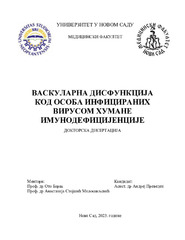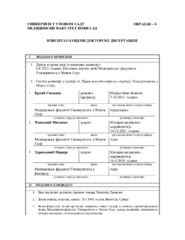Приказ основних података о дисертацији
Vaskularna disfunkcija kod osoba inficiranih virusom humane imunodeficijencije
Vascular dysfunction in people infected with human immunodeficiency virus
| dc.contributor.advisor | Barak, Otto | |
| dc.contributor.advisor | Stojšić-Milosavljević, Anastazija | |
| dc.contributor.other | Brkić, Snežana | |
| dc.contributor.other | Marić, Daniela | |
| dc.contributor.other | Velicki, Lazar | |
| dc.contributor.other | Čanković, Milenko | |
| dc.contributor.other | Zdravković, Marija | |
| dc.creator | Преведен, Андреј | |
| dc.date.accessioned | 2024-03-20T07:51:04Z | |
| dc.date.available | 2024-03-20T07:51:04Z | |
| dc.date.issued | 2024-03-04 | |
| dc.identifier.uri | https://www.cris.uns.ac.rs/DownloadFileServlet/Disertacija169717883291186.pdf?controlNumber=(BISIS)133606&fileName=169717883291186.pdf&id=22088&source=NaRDuS&language=sr | sr |
| dc.identifier.uri | https://www.cris.uns.ac.rs/record.jsf?recordId=133606&source=NaRDuS&language=sr | sr |
| dc.identifier.uri | https://www.cris.uns.ac.rs/DownloadFileServlet/IzvestajKomisije16971788378393.pdf?controlNumber=(BISIS)133606&fileName=16971788378393.pdf&id=22089&source=NaRDuS&language=sr | sr |
| dc.identifier.uri | https://nardus.mpn.gov.rs/handle/123456789/22335 | |
| dc.description.abstract | Uvod: Endotelna disfunkcija ubrzano se razvija kod osoba inficiranih virusom humane imunodeficijencije (HIV) delovanjem samog virusa, neželjenim efektima antiretrovirusne terapije i klasičnim faktorima rizika. Oštećenje endotela je najizraženije na mestima gde je poremećen laminarni tok krvi i gde dominira oscilatorno smicajuće naprezanje sa retrogradnim tokom krvi. Cilj ovog istraživanja bila je procena endotelne funkcije osoba sa HIV infekcijom, kao i provera da li je njihov endotel osetljiviji na kratkotrajno povećanje retrogradnog toka krvi od endotela zdravih ispitanika. Metode: Istraživanje je obuhvatilo 62 osobe sa HIV infekcijom i 38 osoba bez HIV infekcije, kojima je procenjena endotelna funkcija merenjem protokom posredovane dilatacije, čije su vrednosti prezentovane u apsolutnim (FMD) i relativnim (FMD%) vrednostima. Potom je izvršena intervencija kojom je tokom 20 minuta uspostavljeno oscilatorno smicajuće naprezanje i povećanje retrogradnog toka krvi, a zatim je ponovljena procena endotelne funkcije. Rezultati: Početne vrednosti FMD (0,30±0,07 vs. 0,36±0,07 mm; p<0,05) i FMD% (6,84±1,57 vs. 7,89±1,19 %, p<0,05) bile su niže u HIV grupi u odnosu na kontrolnu grupu. FMD i FMD% su nakon intervencije u HIV grupi opali za 0,03 mm i 0,7% (p<0,05), dok su u kontrolnoj grupi opali za 0,09 mm i 2,0% (p<0,05). Krajnje vrednosti FMD i FMD% nakon intervencije nisu se razlikovale između grupa (p>0,05). Zaključak: Osobe sa HIV infekcijom imaju lošiju endotelnu funkciju u odnosu na zdrave osobe. Retrogradni tok krvi i oscilatorno smicajuće naprezanje dovode do pogoršanja endotelne funkcije i kod HIV pacijenata i kod zdravih osoba, ali je ovo pogoršanje znatno izraženije kod zdravih. | sr |
| dc.description.abstract | Introduction: People infected with human immunodeficiency virus (HIV) are more susceptible to endothelial dysfunction due to the virus itself, side effects of the antiretroviral therapy and classical risk factors. Endothelial damage is most prominent at the locations where laminar blood flow is disturbed and oscillatory shear stress with retrograde blood flow is dominating. The goal of this study was to assess the endothelial function in people with HIV, and to determine whether their endothelium is more susceptible to a short-term increase in retrograde blood flow in comparison to healthy individuals. Methods: The study included 62 people with HIV infection and 38 people without HIV infection, in whom endothelial function was assessed using flow- mediated dilatation, which was presented in absolute (FMD) and relative (FMD%) values. The intervention produced oscillatory shear stress and retrograde blood flow during 20 minutes, after which the endothelial function assessment was repeated. Results: Baseline FMD (0.30±0.07 vs. 0.36±0.07 mm; p<0.05) and FMD% (6.84±1.57 vs. 7.89±1.19 %, p<0.05) were lower in the HIV group in compare to controls. FMD and FMD% decreased in the HIV group by 0.03 mm and 0.7% (p<0.05), while in the control group they decreased by 0.09 mm and 2.0% (p<0.05). The post-intervention FMD and FMD% were not different between the groups (p>0.05). Conclusion: People with HIV infection express worse endothelial function in compare to healthy individuals. Retrograde blood flow and oscillatory shear stress deteriorate endothelial function in both HIV patients and healthy controls, although this decline is more pronounced in healthy individuals. | en |
| dc.language | sr (latin script) | |
| dc.publisher | Универзитет у Новом Саду, Медицински факултет | sr |
| dc.rights | openAccess | en |
| dc.rights.uri | https://creativecommons.org/licenses/by-nc-nd/4.0/ | |
| dc.source | Универзитет у Новом Саду | sr |
| dc.subject | vaskularni endotel; brahijalna arterija; vazodilatacija; cirkulacija krvi; brzina protoka krvi; virus humane imunodeficijencije; HIV infekcija; antiretrovirusni lekovi; kardiovaskularne bolesti | sr |
| dc.subject | Endothelium, Vascular; Brachial Artery; Vasodilation; Blood Circulation; Blood Flow Velocity; HIV; HIV Infections; Anti-Retroviral Agents; Cardiovascular Diseases | en |
| dc.title | Vaskularna disfunkcija kod osoba inficiranih virusom humane imunodeficijencije | sr |
| dc.title.alternative | Vascular dysfunction in people infected with human immunodeficiency virus | en |
| dc.type | doctoralThesis | sr |
| dc.rights.license | BY-NC-ND | |
| dc.identifier.fulltext | http://nardus.mpn.gov.rs/bitstream/id/160263/Disertacija_15205.pdf | |
| dc.identifier.fulltext | http://nardus.mpn.gov.rs/bitstream/id/160264/Izvestaj_komisije_15205.pdf | |
| dc.identifier.rcub | https://hdl.handle.net/21.15107/rcub_nardus_22335 |



